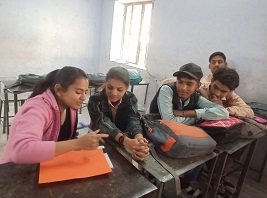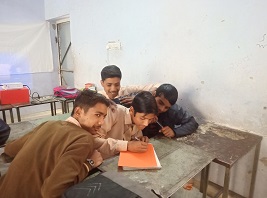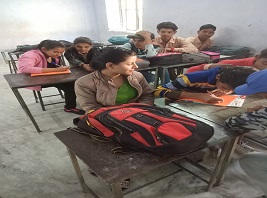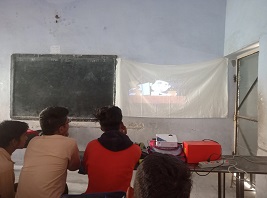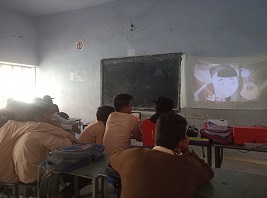Session on Violence and its effects at Shaheed Major Alok Mathur Senior Secondary School in Jhotwara, Jaipur, Rajasthan (February, 2020)
Violence with children and its effects
Summary of violence with children
The definition of violence- The UNCRC considers violence to happen when someone's mind is hurt as well as their body.
Forms of violence by UNCRC: Mental violence, Physical violence, Sexual violence, Violence through information and communication technologies, Violence in mass media, Self-harm, torture or inhuman and degrading treatment or punishment.
ARTICLES :
Article 24 - Children and young people should be protected from the traditional practices that are violent against them. Article 25 - If a child or a young person is living away from home, they should be regularly checked upon, in case, they are not safe. Article 28- No one should be violent against children or young people at school. Article 34 - Children and young people shouldn't be exploited sexually. Article 37 - Children and young people shouldn't be punished in a cruel or degrading way. Article 38- There are rules relating to the involvement of children and young people along with the armed forces. Article 39 - Children and young people should be helped to recover, if they are survivors of violence.
Socially accepted forms of violence, such as shouting at children and corporal punishment, are often not perceived as violent behavior. However, studies indicate that the majority of child abuse occurs at the hands of people known to the child, rather than by strangers. The effects of violence on children can vary based on their age and developmental stage. Exploitation, violence, abuse, and neglect can harm children emotionally, socially, and within their family relationships, and can lead to loss of self-respect, trust, self-esteem, and the joy of childhood. It corrupts, kills, and destroys children, and debases our societies. As parents, it is our primary responsibility to protect our children from violence. Violence against children is unacceptable in all settings, including the home, schools, care or justice institutions, and the community. Parents who resort to violence in their upbringing will not learn alternative methods of educating and dealing with their children.
Activity conducted during the session
Pre-session assessment
Questions with the group:
Which children are safe? Some students responded that children who have good behavior, are educated, come from wealthy families, do not have bad habits, and have good family support are safe. One student said that no children are completely safe. Another boy replied that physically and mentally fit children are safe. Which children are not safe? Some students responded that uneducated children, those who have bad habits, orphaned children, those who lack proper knowledge about society, poor children, and those whose parents are not good are unsafe in society. One student mentioned that disabled children are also unsafe. Which factors make a child safe or unsafe? Most of the students mentioned that family, friends, police, good teachers, children's rights, education, proper nutrition, parenting, and a safe home make a child safe, and vice versa.
Story Writing
We Form 4 groups and each group had to imagine and write a story on the 4 types of violence which are physical violence, emotional violence, sexual violence, exploitation, and negligence respectively. Students wrote the following stories:
Story on physical violence: There was a boy named Ram who was physically violated by his school teachers. He shared this with parents at home but his parents thought that he is not studying that’s why his teachers beat him at school. They didn’t think about their child’s situation. Ram couldn’t survive this violence and committed suicide. All of this happened because of the negligence of his parents as a result of their actions they lost their son. Story on emotional violence: Himanshu and Harshita lived in a village. Himanshu was an elder brother. Their family was an orthodox family. When Himanshu was born in his family everyone was happy and distributed sweets in the whole village but when Harshita was born her family member become sad because she was a girl. Harshita was not permitted to go to school. She wanted to go to school but her parents told her to get involved in household chores because that she was violated mentally by her parents. Her big brother also teased her all time. She complained about him to her parents but they didn’t say anything to him because he was a boy. There was no value of Harshita which made her so stressed. Story on sexual violence: There was a girl who studied in 12th class. After school, she went to a mathematic tuition class. She always reached home late after her class. On her way home, some boys stood on the road after consuming alcohol. They stared at her. After some days those boys started gesticulation to the girl and this activity happened on daily basis. The girl always ignored their activity and the boys courage increased by this and they started to harass that girl on road. One day the boys surrounded the girl and started touching her, pulling off her clothes. Anyhow she ran away from that place and shared all the things with her mother. Her parents filed a case against the boys so that nobody can do such things with any girl. Story on neglecting: There was a boy named Lokesh. His parents did not give him proper love, care and attention. One day he ran away from his house with a man. That man was involved in child trafficking and sold him in a different state. He was exploited by the people, he had to beg for his supervisor and had to stay hungry. Then he gained the courage and ran away from that place. When he came back to his house nobody trusted him not even his parents and friends. Everybody told him that he was mad. Because of that, he became mentally ill and also tried to attempt suicide.
Movie screening
The Rose: This short film is based on Child Rights (Corporal Punishment).The most useful information on Child Abuse. Call on 1098 to report about it. All your information is safe with ChildLine India. (Video Link: https://youtu.be/bqyb4PoLDKc ) KOMAL A film on Child Sexual Abuse (CSA): Komal is like any other bright, sensitive, and happy 7-year-old girl. Her new neighbor Mr. Bakshi, who moved in with his wife, is her father's old friend. Komal bonds with the affable Mr. Bakshi with whom she has a whale of a time. Until Komal discovers Mr.Bakshi's bitter reality. (Video Link: https://youtu.be/CwzoUnj0Cxc ) UNICEF: Stop Child Abuse Now!: Are there 100,000 people who care enough to protect our children from abuse? Let us show abusers in our society we will not tolerate them hurting our children anymore. (Video Link: https://youtu.be/CJzbDn58eTA)


